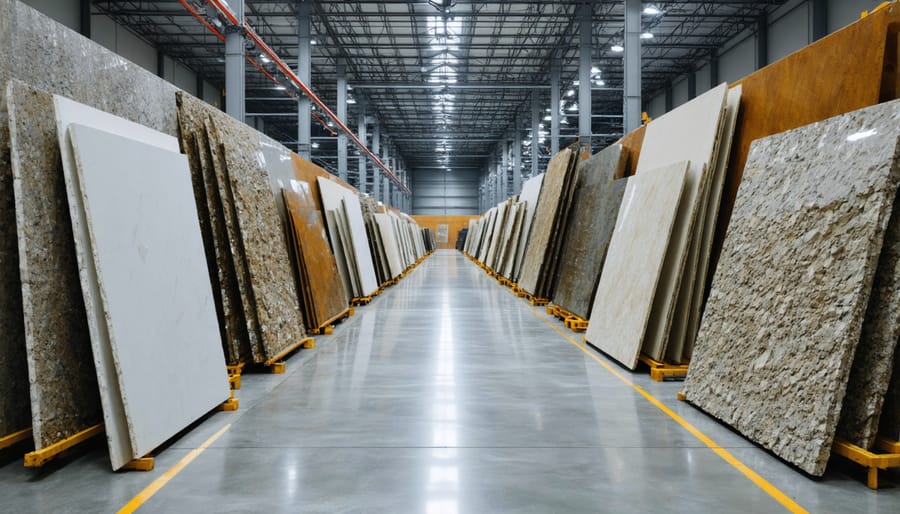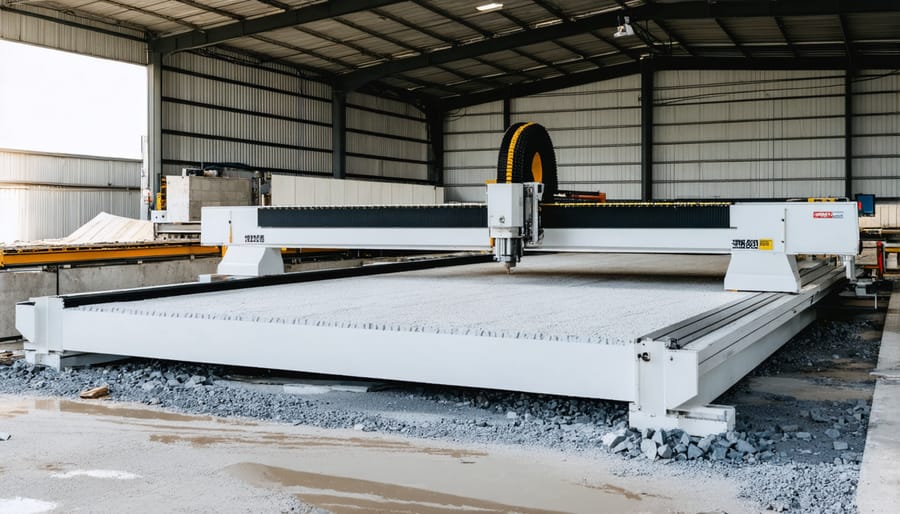Transform your manufacturing processes today with data-driven automation, real-time quality monitoring, and lean optimization techniques that directly impact your bottom line. In today’s competitive stone manufacturing landscape, process improvement isn’t just about incremental changes—it’s about revolutionizing production efficiency while maintaining exceptional product quality.
Modern manufacturing facilities are achieving 30-40% productivity gains through strategic implementation of Industry 4.0 technologies, predictive maintenance systems, and advanced workflow optimization. These improvements dramatically reduce waste, minimize downtime, and ensure consistent product quality across production runs.
By integrating smart sensors, automated material handling systems, and real-time analytics platforms, stone manufacturers can identify bottlenecks, optimize resource allocation, and maintain precise quality control throughout the entire production cycle. This systematic approach to process improvement delivers measurable results: reduced operational costs, enhanced product consistency, and improved workplace safety.
The key to successful manufacturing process improvement lies in balancing technological innovation with practical implementation strategies that consider your facility’s unique challenges and capabilities. Whether you’re modernizing an existing operation or designing new production lines, focused process improvement initiatives deliver immediate and long-term competitive advantages in today’s rapidly evolving manufacturing landscape.
Key Areas for Manufacturing Process Enhancement
Raw Material Handling and Storage
Effective raw material handling and storage is crucial for optimizing manufacturing processes and maintaining product quality. A well-organized storage system reduces waste, improves workflow efficiency, and ensures consistent production output.
Implementing a First-In-First-Out (FIFO) inventory management system helps prevent material deterioration and maintains stock freshness. This approach is particularly important for materials with limited shelf life or those susceptible to environmental damage. Storage areas should be climate-controlled when necessary, with proper ventilation and moisture control to prevent material degradation.
Strategic placement of materials near their point of use reduces unnecessary movement and handling time. Using automated material handling equipment, such as conveyors and automated guided vehicles (AGVs), can significantly decrease labor costs and minimize the risk of damage during transport.
Proper labeling and organization systems are essential for quick material identification and tracking. Implementing barcode or RFID technology enables real-time inventory monitoring and reduces human error in stock management. Regular inventory audits help maintain accurate stock levels and prevent production delays due to material shortages.
Storage optimization should consider both vertical and horizontal space utilization. Modern racking systems and automated storage and retrieval systems (AS/RS) can maximize warehouse space while improving accessibility. Clear aisles and designated storage zones facilitate safe material movement and reduce the risk of accidents.
Establishing standard operating procedures (SOPs) for material handling ensures consistency and safety across all shifts. Regular training programs for staff on proper handling techniques and safety protocols help minimize material damage and workplace injuries. Additionally, implementing preventive maintenance schedules for handling equipment ensures reliable operation and extends equipment life.

Cutting and Fabrication Efficiency
Modern manufacturing facilities have revolutionized their cutting and fabrication processes through advanced stone fabrication techniques and state-of-the-art equipment. Computer Numerical Control (CNC) machines now offer unprecedented precision in cutting operations, reducing material waste by up to 30% compared to traditional methods. These automated systems utilize laser guidance and digital templating to maximize material yield from each stone slab.
Water jet cutting technology has emerged as a game-changer, enabling intricate cuts without thermal stress on the stone. This method not only improves accuracy but also extends tool life and reduces maintenance costs. Advanced nesting software further optimizes material usage by automatically arranging cutting patterns to minimize waste, often achieving material utilization rates above 85%.
Quality control systems integrated with cutting equipment now provide real-time feedback on cut accuracy and surface finish. Digital measuring tools and 3D scanning technology ensure precise dimensions before cutting begins, dramatically reducing errors and rework requirements. Modern dust collection systems have also improved workplace safety while maintaining cleaner cutting environments.
Facilities implementing these improvements typically report significant efficiency gains:
– 40% reduction in cutting time
– 25% decrease in material waste
– 50% improvement in first-pass quality
– 35% reduction in labor costs per piece
These advancements not only boost productivity but also enable manufacturers to take on more complex projects while maintaining consistent quality. The combination of precision equipment and optimized processes has made it possible to achieve tighter tolerances and better finish quality than ever before.
Technology Integration in Stone Manufacturing
Automated Systems and CNC Machinery
Automation has revolutionized stone manufacturing, bringing unprecedented precision and efficiency to traditional processes. Modern CNC (Computer Numerical Control) machinery can transform raw stone blocks into finished products with remarkable accuracy, reducing waste and improving consistency across production runs.
These automated systems excel at repetitive tasks like cutting, polishing, and edge profiling, maintaining consistent quality while significantly increasing output. A single CNC machine can often replace multiple manual workstations, operating continuously with minimal downtime and reducing labor costs.
Advanced software integration allows manufacturers to optimize material usage through digital templating and nesting programs. These systems can calculate the most efficient cutting patterns, maximizing yield from each stone slab while minimizing waste. 3D scanning technology further enhances precision by creating exact digital models of stone pieces before cutting begins.
The implementation of automated systems also improves workplace safety by reducing manual handling of heavy stone materials. Robotic arms and automated material handling systems can move large slabs safely and efficiently, decreasing the risk of workplace injuries.
While the initial investment in automated systems can be substantial, the long-term benefits often justify the cost through increased productivity, reduced waste, and improved quality control. Many manufacturers report ROI within 2-3 years of implementation, particularly in high-volume operations.
For optimal results, companies should carefully assess their production needs and choose automation solutions that align with their specific manufacturing requirements and growth objectives.

Quality Control Technologies
Modern stone manufacturing relies heavily on advanced quality control technologies to maintain consistent product excellence. Digital measuring systems, including laser scanners and 3D imaging devices, now provide precise dimensional accuracy checks throughout the production process. These tools can detect variations as small as 0.1mm, ensuring each piece meets exact specifications.
Automated surface inspection systems use high-resolution cameras and artificial intelligence to identify imperfections, color variations, and structural irregularities that might be missed by the human eye. These systems can analyze thousands of square feet of stone per hour, dramatically improving inspection efficiency while maintaining rigorous quality standards.
Ultrasonic testing equipment helps verify the internal integrity of stone slabs, detecting hidden flaws or potential weak points before they become issues in finished products. This non-destructive testing method has become particularly valuable for ensuring the durability of structural stone elements.
Quality data management systems now integrate these various inspection points, creating comprehensive digital records for each product batch. This allows manufacturers to track trends, identify potential process improvements, and maintain detailed quality documentation for certification requirements. Real-time monitoring capabilities also enable immediate adjustments to production parameters when variations are detected, minimizing waste and ensuring consistent output quality.
Sustainable Manufacturing Practices
Water Recycling Systems
Modern stone manufacturing facilities are implementing advanced water recycling systems to significantly reduce water consumption and environmental impact. These closed-loop systems capture, filter, and reuse water from cutting and polishing processes, typically achieving 95-98% water recovery rates. The recycling process involves multiple stages of filtration, including settling tanks and mechanical filters that remove stone particles and sediment. By incorporating water recycling, manufacturers can save thousands of gallons daily while meeting strict environmental regulations. Advanced monitoring systems ensure water quality remains consistent throughout the recycling process, maintaining optimal cutting and polishing performance. This sustainable approach not only reduces operational costs but also minimizes wastewater discharge and supports environmental compliance.

Manufacturing process improvement is a continuous journey that rewards commitment and strategic implementation. By focusing on data-driven decisions, lean principles, and employee engagement, organizations can achieve significant gains in efficiency, quality, and cost reduction. Remember that successful improvement initiatives require leadership support, clear communication, and regular monitoring of key performance indicators. Start small, measure results, and build upon successes to create lasting positive change in your manufacturing operations.










